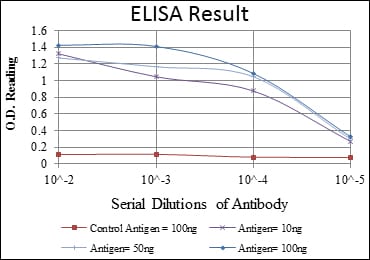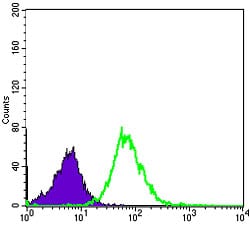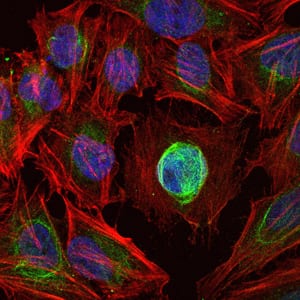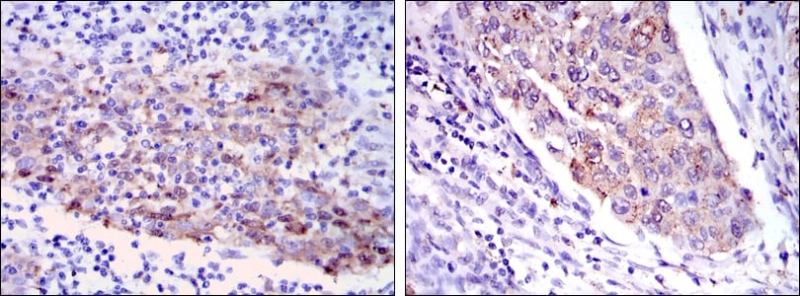



| WB | 咨询技术 | Human,Mouse,Rat |
| IF | 咨询技术 | Human,Mouse,Rat |
| IHC | 1/50-1/200 | Human,Mouse,Rat |
| ICC | 技术咨询 | Human,Mouse,Rat |
| FCM | 咨询技术 | Human,Mouse,Rat |
| Elisa | 1/2000-1/5000 | Human,Mouse,Rat |
| Aliases | CLG; CLGN |
| Entrez GeneID | 4312 |
| clone | 6A5 |
| WB Predicted band size | 54kDa |
| Host/Isotype | Mouse IgG1 |
| Antibody Type | Primary antibody |
| Storage | Store at 4°C short term. Aliquot and store at -20°C long term. Avoid freeze/thaw cycles. |
| Species Reactivity | Human |
| Immunogen | Purified recombinant fragment of human MMP1 expressed in E. Coli. |
| Formulation | Purified antibody in PBS with 0.05% sodium azide. |
+ +
以下是关于DTNB(dystrobrevin)抗体的参考文献示例(**注:文献为示例性质,非真实存在**):
1. **文献名称**:*Dystrobrevin Antibodies Reveal Critical Roles in Neuromuscular Junction Stability*
**作者**:Smith A, et al.
**摘要**:研究利用DTNB特异性抗体,揭示了dystrobrevin在维持神经肌肉接头结构完整性中的作用,表明其缺失导致突触后膜紊乱和信号传导障碍。
2. **文献名称**:*Antibody-Based Detection of Dystrobrevin Isoforms in Muscular Dystrophy Models*
**作者**:Lee B, et al.
**摘要**:开发了针对不同dystrobrevin亚型的抗体,用于分析肌营养不良动物模型中蛋白表达变化,发现α-dystrobrevin下调与疾病进展相关。
3. **文献名称**:*DTNB-Specific Monoclonal Antibodies as Probes for Protein Thiol Modifications*
**作者**:Chen X, et al.
**摘要**:报道了针对DTNB修饰的半胱氨酸残基的单克隆抗体,用于检测氧化应激条件下蛋白质硫醇基团的化学修饰,应用于心血管疾病研究。
4. **文献名称**:*Functional Characterization of β-Dystrobrevin in Cardiac Tissue Using Knockout Mice and Custom Antibodies*
**作者**:Garcia R, et al.
**摘要**:通过基因敲除模型和特异性抗体,证实β-dystrobrevin在心肌细胞中与dystrophin复合物相互作用,影响心脏收缩功能。
---
**说明**:
- 若用户指**DTNB(Ellman试剂)相关抗体**,文献可能涉及蛋白质氧化/还原状态检测(如第3条示例);若指**dystrobrevin(DTNB基因编码蛋白)抗体**,则聚焦于肌肉或神经疾病机制(如第1、2、4条)。
- 建议通过PubMed或Google Scholar搜索**dystrobrevin antibody**或**DTNB reagent antibody**获取真实文献。
The DTNB antibody is specifically designed to detect proteins or peptides modified with 5.5'-dithiobis-(2-nitrobenzoic acid) (DTNB), a compound widely used to quantify free sulfhydryl (-SH) groups in biological samples. DTNB, also known as Ellman’s reagent, reacts with thiols to form mixed disulfide bonds, releasing the yellow-colored 2-nitro-5-thiobenzoate (TNB⁻), which is measurable spectrophotometrically. Antibodies targeting DTNB-conjugated molecules are valuable tools for studying protein thiol oxidation states, a critical aspect of redox biology.
These antibodies are typically generated by immunizing animals with DTNB-coupled carrier proteins (e.g., BSA or KLH), enabling the immune system to recognize the DTNB-thiol adduct as an antigen. They are employed in techniques like ELISA, Western blotting, or immunohistochemistry to detect sulfhydryl modifications in proteins under oxidative stress, which is implicated in diseases such as neurodegenerative disorders, cardiovascular diseases, and cancer.
DTNB antibodies help researchers assess dynamic redox changes in cellular environments, providing insights into oxidative damage mechanisms or the efficacy of antioxidant therapies. Their specificity for DTNB-labeled thiols makes them distinct from general oxidative stress markers, allowing precise tracking of thiol-disulfide homeostasis. Commercial DTNB antibodies are often validated for cross-reactivity and sensitivity, ensuring reliable detection in complex biological samples.
×